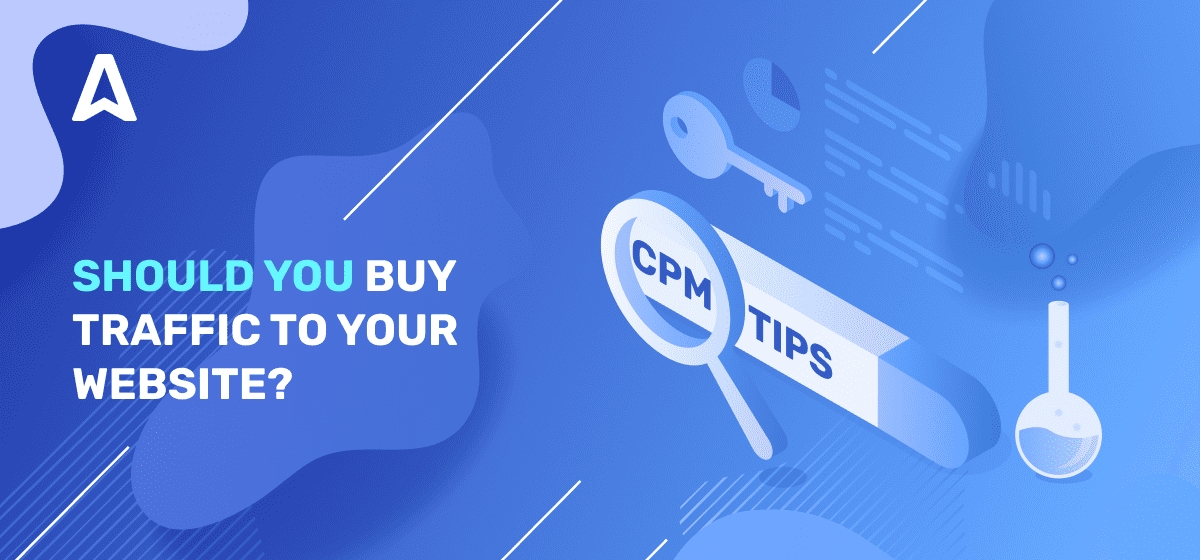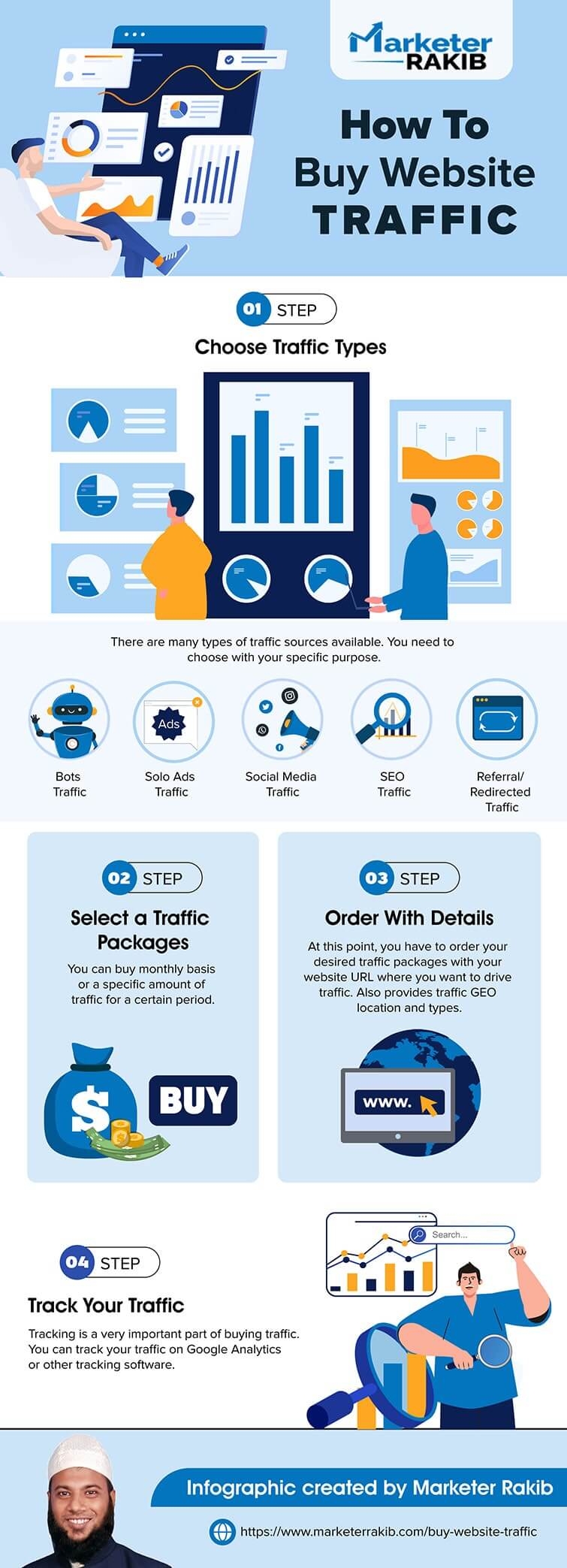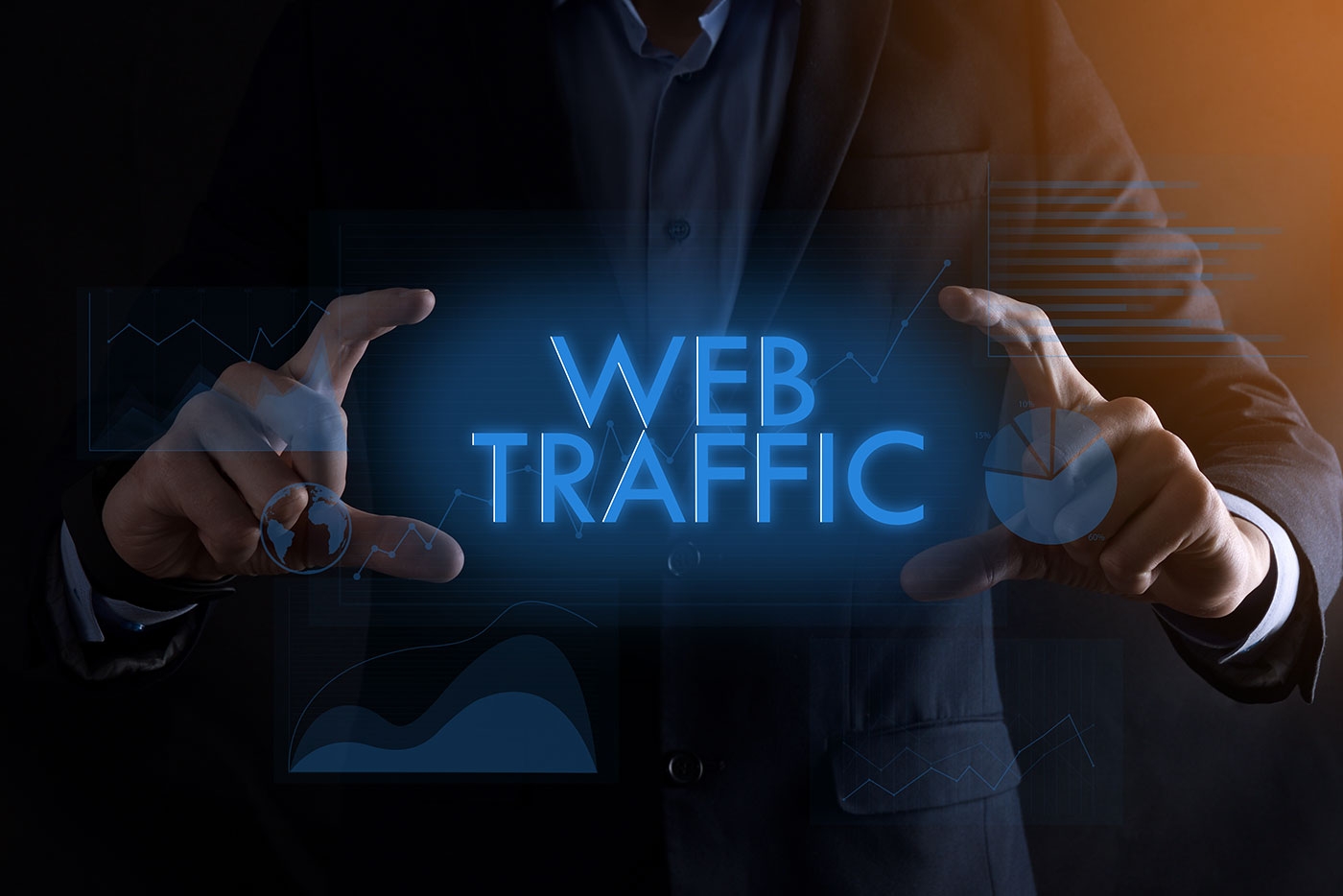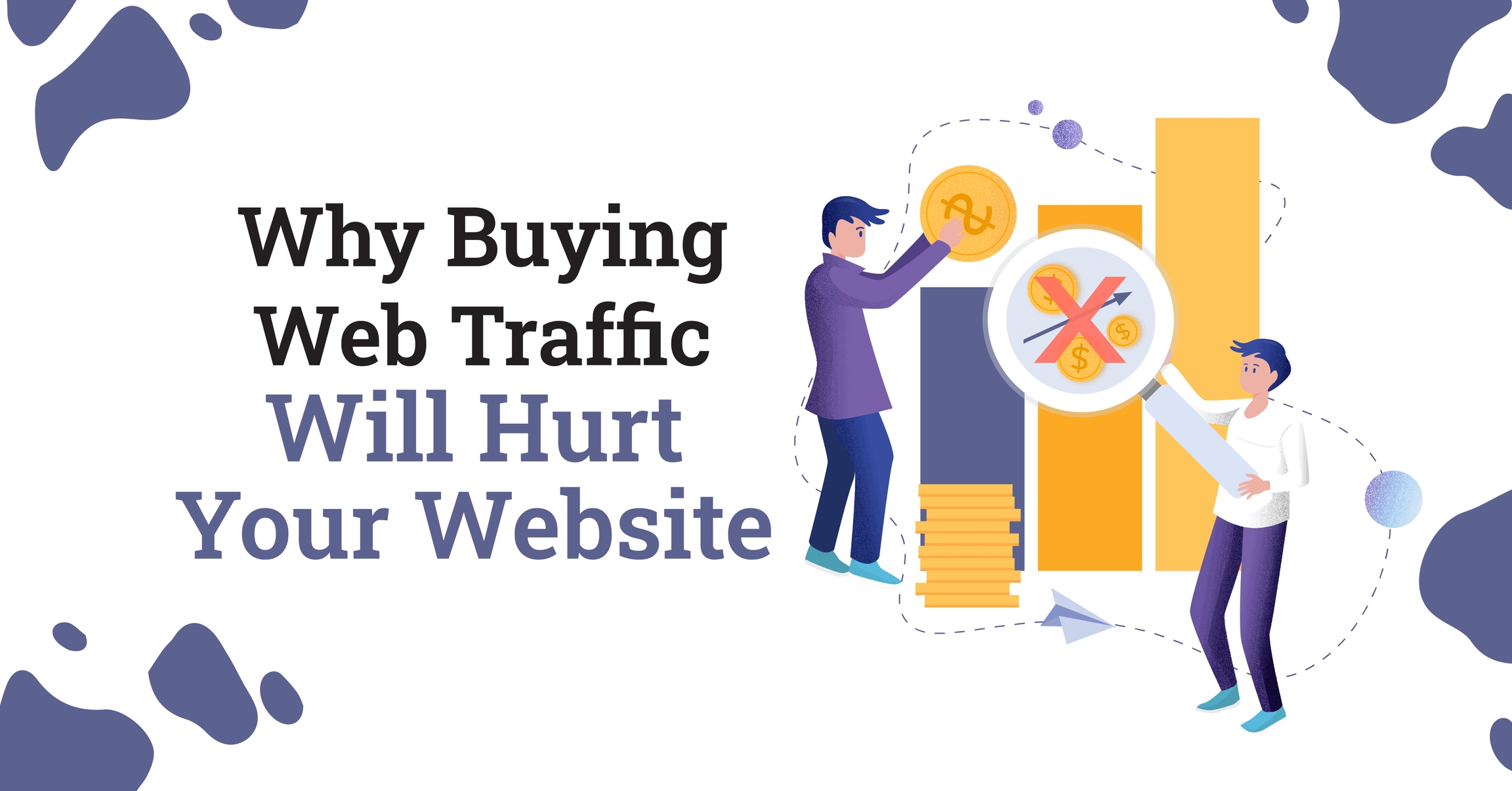Buy Best Website Traffic | Boost Traffic & Conversions
Best High Quality Traffic with Automatic Targeting & Smart Goals from US & 150+ Countries
Tips for purchasing website traffic to boost online visibility
Buy CPC Traffic | Buy Display Ads | Exclusive traffic sources | Buy Push Ads | Popunder ADS | Buy Native Ads | Buy Preroll Ads

Buy CPC Traffic | Buy Display Ads | Exclusive traffic sources | Buy Push Ads | Popunder ADS | Buy Native Ads | Buy Preroll Ads
Are you struggling to drive traffic to your website or blog? Don't worry, you're not alone. Many website owners and marketers face this challenge as they try to establish themselves in the digital world. One strategy that has gained popularity in recent years is buying traffic. In this comprehensive guide, we will delve into the world of buying traffic and explore its benefits, risks, and best practices.
What exactly is buying traffic?
Buying traffic refers to the practice of acquiring visitors to your website or blog through paid sources, such as advertising networks or social media platforms. Instead of relying solely on organic search or word-of-mouth, buying traffic allows you to tap into a larger pool of potential visitors and increase your chances of generating leads or sales.
But is it worth the investment?
Many skeptics argue that buying traffic is not a sustainable long-term strategy and that organic traffic is the way to go. However, when done correctly, buying traffic can be a valuable tool in your marketing arsenal. It can help jumpstart your website's growth, increase brand visibility, and attract highly targeted visitors who are more likely to convert into customers or subscribers. In this guide, we will explore the different types of paid traffic, how to choose the right sources, and tips for optimizing your campaigns to maximize ROI.
What is Buying Traffic and How Does it Work?
Buying traffic refers to a digital marketing strategy where businesses pay to drive more visitors to their website. This can be done through various channels such as display advertising, search engine marketing, social media advertising, and affiliate marketing.
The concept behind buying traffic is to increase the volume of visitors to a website, which can potentially lead to more conversions and sales. By purchasing traffic, businesses can reach a larger audience and increase their online visibility.
There are different ways in which buying traffic works:
Display Advertising: Businesses can buy ad space on websites or mobile apps to promote their products or services. These ads can be in the form of banners, pop-ups, or video ads.
Search Engine Marketing: By buying traffic through search engines, businesses can bid on specific keywords that are relevant to their industry. When users search for those keywords, their ads appear at the top of the search engine results pages.
Social Media Advertising: Popular social media platforms like Facebook, Instagram, and Twitter offer advertising options where businesses can pay to show their ads to a targeted audience. This allows them to reach users who may be interested in their products or services.
Affiliate Marketing: Businesses can partner with affiliate marketers who promote their products or services on their websites or blogs. In return, the affiliates receive a commission for each sale or lead generated through their referral.
When buying traffic, businesses need to consider their target audience, budget, and the effectiveness of different advertising channels. It is important to choose the right channels that are most likely to reach the desired audience and provide a good return on investment.
The Benefits of Buying Traffic for Your Website

Every website owner understands the importance of attracting visitors to their site. After all, more traffic means increased exposure, potential sales, and growth opportunities. One effective way to drive traffic to your website is by buying traffic. While some may question the effectiveness of this strategy, there are several benefits to buying traffic for your website.
1. Immediate Results

When you buy display ads or invest in other forms of paid traffic, you can start seeing results almost immediately. Unlike organic traffic, which can take time to build up, buying traffic allows you to get a head start and generate instant visibility for your website.
2. Targeted Audience
Another advantage of buying traffic is the ability to target your audience effectively. Various advertising platforms offer advanced targeting options, allowing you to reach the right people who are more likely to be interested in your products or services. By narrowing down your target audience, you can increase the chances of converting visitors into customers.
3. Control and Flexibility
Buying traffic also gives you control and flexibility over your advertising campaigns. You can adjust your budget, set a specific timeframe, and optimize your ads based on real-time data and performance metrics. This level of control allows you to make strategic decisions and maximize the return on your investment.
In conclusion, investing in buying traffic for your website can be a smart move that provides immediate results, allows you to target a specific audience, and gives you control over your advertising campaigns. Whether you buy display ads or opt for other paid traffic methods, it's essential to monitor and analyze the outcomes to ensure you're getting the desired results and adjusting your strategy as needed.
Types of Bought Traffic
When it comes to buying traffic for your website, there are various types of traffic that you can choose from. Each type has its own characteristics and can target different audiences. Here are some of the most common types of bought traffic:
1. Display Advertising
Display advertising involves purchasing ad space on websites or apps. These ads can be in the form of banners, pop-ups, or interstitials. Display advertising is a great way to generate awareness and reach a wide audience. It can be targeted based on factors such as demographics, interests, and browsing behavior.
2. Search Engine Advertising
Search engine advertising, also known as pay-per-click (PPC) advertising, involves paying for ad placements on search engine results pages. These ads appear at the top or bottom of the search results and are usually marked as "sponsored." Search engine advertising allows you to target specific keywords and display your ads to users who are actively searching for related products or services.
3. Social Media Advertising
Social media advertising involves promoting your website or content on social media platforms such as Facebook, Instagram, Twitter, or LinkedIn. These platforms offer advanced targeting options, allowing you to reach specific demographics, interests, or behaviors. Social media advertising can be in the form of sponsored posts, display ads, or video ads.
It's important to note that each type of bought traffic has its own advantages and disadvantages. It's essential to carefully consider your target audience, goals, and budget before choosing the type of traffic to purchase.
Remember to analyze and track the performance of your bought traffic to ensure that you are getting a satisfactory return on investment (ROI).
Targeted vs. Non-Targeted Traffic
When it comes to buying traffic for your website, there are two main categories to consider: targeted and non-targeted traffic. Understanding the differences between these two types of traffic can help you make more informed decisions and achieve better results with your traffic acquisition strategies.
Targeted Traffic
Targeted traffic refers to visitors who are specifically interested in the products, services, or content that your website offers. These visitors are more likely to engage with your site, convert into customers, and generate valuable actions such as making a purchase or subscribing to your newsletter. Targeted traffic is often achieved by using specific targeting criteria, such as demographics, interests, or keywords, to reach the right audience.
Benefits of targeted traffic:
Higher conversion rates: Since targeted traffic consists of users who are interested in what you offer, they are more likely to convert into customers or take desired actions on your site.
Better engagement: When visitors are interested in your products or services, they are more likely to spend more time on your site, explore different pages, and interact with your content.
Improved ROI: By reaching the right audience, you'll achieve better return on investment (ROI) as you're spending money on traffic that is more likely to generate revenue or valuable actions.
Non-Targeted Traffic
Non-targeted traffic, on the other hand, refers to visitors who are not specifically interested in what your website offers. This type of traffic can be acquired through various methods, such as using generic keywords, advertising on general platforms, or using broad targeting criteria. Non-targeted traffic may result in higher visitor numbers but may have lower conversion rates and engagement compared to targeted traffic.
Limitations of non-targeted traffic:
Lower conversion rates: Since non-targeted traffic consists of visitors who may not be interested in your products or services, they are less likely to convert into customers or take desired actions.
Poor engagement: Visitors who are not interested in your site are more likely to leave quickly, resulting in higher bounce rates and lower time spent on your site.
Decreased ROI: As non-targeted traffic may not generate as many desired actions, your return on investment (ROI) may be lower compared to targeted traffic.
In conclusion, while non-targeted traffic may result in higher visitor numbers, targeted traffic is more likely to lead to conversions, engagement, and a higher return on investment. It's important to consider your specific goals and target audience when choosing the type of traffic to invest in.
Pros and Cons of Buying Traffic
Buying traffic, or paying for a service to drive visitors to your website, can be an effective marketing strategy for many businesses. However, like any marketing tactic, there are pros and cons to consider before investing in buying traffic.
Pros:

Increased visibility: By purchasing traffic, you can increase the visibility of your website and reach a wider audience. This can lead to more brand awareness and potential new customers.
Immediate results: Buying traffic can provide immediate results, unlike organic methods that can take time to build traction. This is especially beneficial for businesses looking to generate leads or sales quickly.
Targeted audience: Many services that sell traffic allow you to target specific demographics or interests, ensuring that the visitors you receive are more likely to be interested in your product or service.
Control over campaign: When buying traffic, you have more control over your marketing campaign. You can choose the duration of the campaign, the number of visitors, and even split test different landing pages.
Cons:
Cost: Buying traffic can be expensive, especially for businesses with limited marketing budgets. It's important to consider the return on investment and whether the cost is justified based on the potential benefits.
Potential for low-quality traffic: Not all traffic is created equal. Some providers may deliver low-quality traffic from sources like bots or click farms. This can result in a high bounce rate and low conversion rates.
Risk of relying solely on paid traffic: Buying traffic should not be the sole focus of your marketing strategy. It's important to diversify and also invest in organic methods like SEO and content marketing to build a sustainable online presence.
Lack of long-term growth: While buying traffic can provide immediate results, it may not contribute to long-term growth, especially if you don't have a solid strategy for converting those visitors into loyal customers.
In conclusion, buying traffic can be a useful tool in your marketing toolbox, but it's important to weigh the pros and cons before making a decision. Consider your budget, goals, and overall marketing strategy to determine if buying traffic aligns with your business objectives.
How to Choose the Right Traffic Provider
Buying traffic can be a valuable strategy for increasing your website's visibility and attracting more potential customers. However, choosing the right traffic provider is crucial to ensure you get high-quality and relevant traffic that will actually benefit your business. Here are some factors to consider when selecting a traffic provider:
1. Targeted Traffic
One of the most important things to consider when choosing a traffic provider is the targeting options they offer. Make sure they can provide traffic that is relevant to your niche or industry. This will ensure that the visitors who come to your site are more likely to be interested in your products or services, increasing the chances of conversions.
2. Quality Assurance
Check if the traffic provider has quality assurance measures in place. Make sure they have systems to filter out bot traffic, which can artificially inflate your visitor count and skew your analytics. A reputable traffic provider will have strict measures in place to guarantee that the traffic they deliver is genuine and of high quality.
Additionally, you can ask for references or read reviews from other customers to ensure the traffic provider has a good reputation and a track record of delivering on their promises.
3. Pricing and Budget
Consider your budget and the pricing options provided by the traffic provider. Compare the rates of different providers to ensure you are getting a competitive price for the amount of traffic you want. However, be wary of providers that offer extremely cheap rates, as this could be an indicator of low-quality traffic or even fraudulent practices.
It's also important to consider the return on investment (ROI) when it comes to buying traffic. Calculate the potential revenue that can be generated from the increased traffic and compare it to the cost of the traffic to determine if it's a worthwhile investment for your business.
In conclusion, choosing the right traffic provider is essential for achieving your marketing goals. By considering factors such as targeted traffic, quality assurance, and pricing, you can make an informed decision that will drive relevant and high-quality traffic to your website.
Factors to Consider Before Buying Traffic
Purchasing traffic for your website can be an effective strategy to increase visibility and reach a larger audience. However, before investing in any traffic sources, it is crucial to consider certain factors to ensure that you are making a wise decision.
1. Target Audience:
Understanding your target audience is essential before buying traffic. Determine the demographics, interests, and behavior of your desired audience. By knowing this information, you can select traffic sources that align with your target audience, leading to better engagement and conversion rates.
2. Quality of Traffic:
When buying traffic, always prioritize quality over quantity. Analyze the traffic sources and their reputations. Look for sources that provide high-quality traffic, meaning visitors who are genuinely interested in your products or services. Quality traffic will result in higher engagement and better overall performance.
3. Source Verification:
Verify the legitimacy and reliability of the traffic sources before making a purchase. Research the sources, read reviews, and track their performance history. Avoid sources that are known for fraudulent practices or have a high percentage of bot traffic. It is crucial to invest in verified and trustworthy sources to ensure the effectiveness of your traffic campaigns.
4. Cost and Budget:
Consider your budget and the cost of buying traffic. Set realistic expectations by aligning your budget with your desired goals. Compare prices across different traffic sources and choose the ones that provide good value for your money. Remember that investing in quality traffic may require a higher budget, but it is worth it for long-term success.
5. Campaign Monitoring:
After buying traffic, ongoing monitoring and analysis are crucial. Keep track of key metrics such as conversion rates, bounce rates, and time-on-page. Continuously optimize your campaigns based on the data gathered. By monitoring and improving your campaigns, you can maximize the return on investment (ROI) and improve the overall performance of your website.
Conclusion:
Buying traffic can be a valuable strategy to boost your website's visibility and increase conversions. However, it is essential to consider factors such as target audience, quality of traffic, source verification, cost and budget, and campaign monitoring before making a purchase. By carefully evaluating these factors, you can make an informed decision and ensure the success of your traffic campaigns.
How to Track and Analyze Traffic Bought
Buying traffic is a common practice for businesses looking to increase their online visibility and attract more potential customers. However, simply buying traffic is not enough to drive success. It is important to track and analyze the traffic purchased to ensure that the investment is yielding the desired results. Here are some steps to effectively track and analyze traffic bought:
1
Define the goals and objectives
2
Set up tracking tools
3
Track the traffic source
4
Monitor the quality of the traffic
5
Analyze the conversion rate
6
Optimize the traffic campaign
Step 1: Define the goals and objectives
Before tracking and analyzing the bought traffic, it is essential to clearly define the goals and objectives of the campaign. This could be increasing website traffic, generating leads, or boosting sales. Defining the goals will help in selecting the appropriate tracking metrics and tools.
Step 2: Set up tracking tools
To effectively track the traffic bought, it is important to set up tracking tools such as Google Analytics or other third-party tracking software. These tools will provide valuable insights into the performance of the traffic campaign, including important metrics like page views, bounce rate, and average time on site.
Step 3: Track the traffic source
In order to determine the effectiveness of the bought traffic, it is crucial to track the source of the traffic. This can be done by using UTM parameters or affiliate tracking codes. Tracking the traffic source will help in identifying the most effective channels and campaigns that are driving the desired results.
Step 4: Monitor the quality of the traffic
Not all traffic is created equal. It is important to monitor the quality of the traffic bought to ensure that it is relevant and engaging. This can be done by analyzing metrics such as bounce rate, time on site, and conversion rate. By monitoring the quality of the traffic, adjustments can be made to optimize the campaign and attract higher-quality visitors.
Step 5: Analyze the conversion rate
The ultimate goal of buying traffic is to drive conversions. It is crucial to analyze the conversion rate of the bought traffic to determine its effectiveness in generating leads or sales. This can be done by setting up conversion tracking in the tracking tools and analyzing the data regularly. By analyzing the conversion rate, adjustments can be made to improve the campaign's performance and ROI.
Step 6: Optimize the traffic campaign
Based on the insights gained from tracking and analyzing the traffic bought, it is important to continually optimize the traffic campaign. This can involve making adjustments to targeting criteria, ad creatives, or landing pages. Optimization should be an ongoing process to ensure that the bought traffic is delivering the desired results and maximizing the return on investment.
In conclusion, tracking and analyzing the traffic bought is essential to ensure the success of any traffic campaign. By defining goals, setting up tracking tools, monitoring the quality of the traffic, analyzing conversion rates, and optimizing the campaign, businesses can make informed decisions and maximize their investment in buying traffic.
How to Increase Conversion Rates with Bought Traffic
Buying traffic can be a great strategy to drive more visitors to your website, but it's not enough to just get more people to your site. To truly succeed, you need to focus on increasing your conversion rates. Here are some tips to help you make the most out of your bought traffic:
1. Target the Right Audience
One of the key factors in increasing your conversion rates with bought traffic is targeting the right audience. Before you start buying traffic, make sure you have a clear understanding of your target audience and what they are looking for. This will help you choose the right platforms and channels to reach them.
2. Create Compelling Landing Pages
Landing pages are crucial when it comes to converting your traffic into customers. Make sure your landing pages are compelling, visually appealing, and easy to navigate. Clearly communicate the value proposition of your product or service and include clear call-to-action buttons to encourage conversions.
3. Optimize for Mobile
With the increasing number of people using mobile devices, it's essential to optimize your website and landing pages for mobile. Make sure your website is responsive and loads quickly on mobile devices. This will provide a better user experience and increase the likelihood of conversions.
4. Test and Optimize
Constantly testing and optimizing your website and landing pages is key to improving your conversion rates. Set up A/B tests to compare different versions of your pages and analyze the data to identify what works best. Make data-driven decisions and continuously refine your approach to maximize conversions.
5. Offer Social Proof and Trust Signals
Building trust with your visitors is essential to encourage conversions. Include social proof such as customer testimonials, reviews, and case studies to demonstrate the credibility of your product or service. Incorporate trust signals such as security badges and money-back guarantees to eliminate any doubts or concerns your visitors may have.
6. Follow Up and Nurture Leads
Not all conversions will happen on the first visit. Implement lead nurturing strategies to stay connected with your visitors and guide them towards a conversion. Use email marketing, retargeting ads, and personalized content to keep your brand top of mind and encourage repeat visits.
By implementing these strategies, you can significantly increase your conversion rates with bought traffic. Remember to continually monitor your analytics, stay updated on industry trends, and adapt your strategies accordingly. With the right approach, bought traffic can be a valuable investment that generates a high return on investment.
Mistakes to Avoid When Buying Traffic
1. Lack of Research: One of the biggest mistakes that people make when buying traffic is not conducting enough research beforehand. It's important to understand the target audience, demographics, and interests when selecting a traffic source. Without researching and identifying the right sources, you may end up wasting your money on traffic that won't convert.
2. Focusing Solely on Quantity: Another mistake is obsessing over the quantity of traffic rather than the quality. It's not about getting as much traffic as possible, but rather about getting targeted, high-quality traffic that is more likely to convert. It's important to prioritize quality over quantity to ensure that your marketing efforts are effective.
3. Falling for Cheap Traffic: While it may be tempting to go for cheap traffic, it's often a mistake. Cheap traffic sources may deliver low-quality traffic that is not relevant to your business or may even be generated by bots. Such traffic not only fails to convert but may also harm your website's reputation. It's better to invest in legitimate traffic sources even if they cost a little more.
4. Ignoring Analytics: Many marketers overlook the importance of tracking and analyzing traffic data. By tracking key metrics such as bounce rate, conversion rate, and average session duration, you can gain valuable insights into your traffic sources and optimize your campaigns. Ignoring analytics can lead to missed opportunities for improvement and hinder your overall marketing strategy.
5. Lack of Testing and Optimization: Buying traffic is not a one-time solution. It requires continuous testing and optimization to achieve the best results. Testing different traffic sources, ad creatives, and landing pages can help you identify what works best for your business. Experimenting and tweaking your campaigns based on data-driven insights can lead to better conversion rates and maximize your return on investment.
6. Not Setting Clear Goals: Without clear goals, it's difficult to measure the success of your traffic-buying efforts. It's important to define specific objectives and key performance indicators (KPIs) before purchasing traffic. Whether you aim for more sales, leads, or brand awareness, setting clear goals will help you assess the effectiveness of your campaigns and make informed decisions for future strategies.
7. Neglecting the Landing Page: Your landing page plays a crucial role in converting traffic into leads or sales. Neglecting to optimize your landing page for user experience, relevance, and conversion can result in wasted traffic. Make sure your landing page is user-friendly, visually appealing, and aligned with the interests and needs of your target audience.
Conclusion: Buying traffic can be an effective strategy to boost your online presence and drive conversions. However, it's important to avoid these common mistakes to ensure that your investment in traffic buying pays off. Conduct thorough research, prioritize quality over quantity, invest in legitimate sources, track and analyze data, test and optimize continuously, set clear goals, and optimize your landing page for maximum success.
Legal and Ethical Considerations of Bought Traffic
Buying traffic can be an effective strategy for increasing website visibility and driving more visitors to your page. However, it is important to consider the legal and ethical implications of purchasing traffic to ensure that you are engaging in legitimate practices that align with industry standards.
Legal Considerations

When buying traffic, it is crucial to ensure that you are not violating any laws or regulations. This includes adhering to copyright laws by not using copyrighted content without permission, avoiding deceptive practices that may be considered fraudulent, and complying with privacy laws to protect user data.
It is important to carefully review the terms and conditions of any traffic provider you consider partnering with to ensure that their practices align with legal requirements. Additionally, monitor your purchased traffic to ensure that it does not violate any laws or regulations, as the responsibility ultimately falls on you as the website owner.
Ethical Considerations
While the legality of buying traffic is important, ethical considerations are equally crucial. Buying traffic should not be used to artificially inflate website statistics or mislead users. It should be used as a means to reach a larger audience genuinely interested in the content or products you offer.
Transparency is key when it comes to ethical traffic buying. Make sure to clearly disclose any sponsored content or paid promotions to your users, and avoid engaging in any deceptive practices that may undermine trust and credibility with your audience.
It is also important to consider the impact of purchased traffic on other websites. Understand that by purchasing traffic, you are essentially diverting visitors from other websites to yours. While this is not inherently unethical, it is important to be mindful of the potential consequences and ensure that your practices are fair and respectful of other website owners.
In conclusion, when engaging in the practice of buying traffic, it is essential to consider both legal and ethical implications. Complying with relevant laws, being transparent with your users, and respecting the rights and interests of others are key factors in ensuring a positive and sustainable approach to purchasing traffic.
Budgeting for Bought Traffic
When it comes to buying traffic for your website, it's important to set a budget to ensure that you're getting the most out of your investment. Here are some key steps to help you budget for bought traffic:
Define your goals: Before setting a budget, it's important to clearly define your goals. Are you looking to increase sales, boost brand awareness, or drive more traffic to your site? Knowing your goals will help you determine how much traffic you need and how much you're willing to spend.
Research traffic costs: Research and analyze the costs associated with different traffic sources. This will help you understand the potential traffic that you can get within your budget. Consider factors such as the cost per click (CPC), cost per thousand impressions (CPM), and cost per acquisition (CPA) when evaluating different traffic options.
Set a budget: Once you have a clear understanding of the costs, set a budget that aligns with your goals and financial resources. Consider both short-term and long-term budgets to accommodate ongoing traffic needs and potential fluctuations in costs.
Monitor and optimize: Regularly monitor the performance of your bought traffic and make necessary adjustments. Analyze key metrics such as conversion rates, click-through rates, and return on investment (ROI) to identify areas for optimization.
Allocate funds strategically: Distribute your budget strategically across different traffic sources based on their performance and potential return. Consider diversifying your traffic sources to minimize risk and maximize results.
Track and analyze results: Track and analyze the results of your bought traffic campaigns to assess their effectiveness. Measure the impact of the traffic on your overall website performance and compare it to your predefined goals to determine the success of your investment.
By following these steps, you can budget effectively for bought traffic and optimize your investment to achieve your desired outcomes.
Alternatives to Buying Traffic

While buying traffic can be an effective strategy to drive visitors to your website, it is not the only option available. If you are looking for alternative ways to increase your website traffic, consider the following options:
1. Content Marketing: Creating high-quality, valuable content is a proven way to attract organic traffic to your website. By consistently producing relevant and engaging articles, blog posts, videos, and infographics, you can position yourself as an expert in your industry and attract a loyal audience.
2. Search Engine Optimization (SEO): Optimizing your website for search engines can significantly increase your organic traffic. By researching relevant keywords, improving your website's structure, and creating high-quality backlinks, you can improve your website's visibility in search engine results and attract more visitors.
3. Social Media Marketing: Building a strong presence on social media platforms can help you reach a wider audience and drive traffic to your website. By sharing engaging content, interacting with your followers, and running targeted ads, you can increase brand awareness and attract visitors who are interested in your products or services.
4. Influencer Marketing: Collaborating with influencers in your industry can help you reach their followers and drive traffic to your website. By partnering with influencers who have a similar target audience, you can leverage their influence to attract new visitors and potential customers.
5. Email Marketing: Building an email list and nurturing your subscribers can be a valuable source of website traffic. By sending regular newsletters, promoting your content, and offering exclusive deals or discounts, you can drive traffic and increase engagement with your audience.
6. Referral Programs: Encouraging your existing customers to refer their friends and family to your website can help you generate additional traffic. By offering incentives such as discounts, rewards, or exclusive content, you can motivate your customers to spread the word about your business and attract new visitors.
7. Guest Blogging: Writing guest posts for other websites in your industry can help you expand your reach and attract new visitors. By sharing your expertise and linking back to your website, you can drive traffic from the guest blog's audience and establish yourself as a trusted authority.
Remember, while buying traffic can provide a quick boost to your website's traffic, it is important to also focus on long-term strategies that can attract organic traffic and build a loyal audience. By combining different marketing tactics and regularly evaluating and adjusting your strategies, you can achieve sustainable growth for your website.
Final Thoughts on Buying Traffic
Buying traffic can be a great strategy to increase the visibility and reach of your website. However, it is important to approach this tactic with caution and proper planning.
Here are some final thoughts to consider:
Quality over quantity: It's essential to prioritize quality traffic over a high number of visitors. Ensure that the traffic you are purchasing aligns with your target audience and is likely to convert into meaningful actions on your site.
Diversify your sources: Relying on one traffic source can be risky. Explore multiple platforms and networks to diversify your traffic sources and reduce the dependence on a single channel.
Set a budget: Determine a budget specifically for buying traffic and closely monitor its performance. Keep track of the return on investment (ROI) to ensure you are getting value for your money.
Test and optimize: Continuously test different traffic sources, ad formats, and targeting techniques to find what works best for your website. Regularly analyze data and make adjustments to optimize your campaigns for better results.
Focus on building organic traffic: While purchasing traffic can provide a temporary boost, it should not be the sole focus of your digital marketing strategy. Invest time and effort in improving your website's organic visibility through SEO, content marketing, and social media engagement.
In conclusion, buying traffic can be an effective tactic to complement your overall marketing efforts. However, it requires strategic planning, monitoring, and continuous optimization to yield the desired results. By focusing on quality, diversification, budgeting, testing, and organic growth, you can make the most out of your investment in buying traffic.
What is buying traffic?
Buying traffic refers to the practice of acquiring visitors to a website through various paid methods, such as advertisements and sponsored content. It is a strategy used by businesses and website owners to increase their online visibility and reach a broader audience.
How effective is buying traffic for increasing website traffic?
Buying traffic can be effective for increasing website traffic, as it allows businesses to target specific demographics and reach a larger audience. However, the effectiveness may vary depending on factors such as the quality of the traffic, the relevance of the content to the target audience, and the overall marketing strategy of the business.
What are some popular methods of buying traffic?
Some popular methods of buying traffic include pay-per-click (PPC) advertising, display advertising, social media advertising, influencer marketing, and native advertising. These methods allow businesses to target specific websites or social media platforms and reach their desired audience.
Are there any risks associated with buying traffic?
Yes, there are certain risks associated with buying traffic. One risk is that the traffic may not be of high quality, meaning it may not genuinely be interested in the content or products offered on the website. Additionally, if businesses rely too heavily on bought traffic, they may neglect other organic marketing strategies that could provide more sustainable long-term results.
How can businesses measure the success of their bought traffic?
Businesses can measure the success of their bought traffic by monitoring key performance indicators (KPIs) such as the number of website visitors, conversion rates, bounce rates, and time spent on the website. By analyzing these metrics, businesses can determine the effectiveness of their bought traffic and make any necessary adjustments to their marketing strategy.
What is buying traffic?
Buying traffic refers to the practice of purchasing visits to your website or landing page from third-party sources. It is a way of increasing the visibility of your website and getting more visitors.
Why do people buy traffic?
People buy traffic to increase the number of visitors to their website or landing page. This can be beneficial for various reasons, such as boosting sales, increasing brand awareness, or gaining more leads for their business.
Is buying traffic effective?
Buying traffic can be effective if done correctly and targeted towards the right audience. However, it is important to note that not all traffic sources are of high quality, so it is crucial to choose reputable sources that provide relevant traffic.
What are the risks of buying traffic?
There are several risks associated with buying traffic. One risk is that the traffic may not be high quality or targeted, resulting in low conversion rates. Another risk is the potential for click fraud or bot traffic, which can lead to wasted advertising spend. It is important to carefully research and choose reputable traffic sources to minimize these risks.
Buy CPC Traffic | Buy Display Ads | Exclusive traffic sources | Buy Push Ads | Popunder ADS | Buy Native Ads | Buy Preroll Ads
2022-2024 @ Buying traffic
Last updated